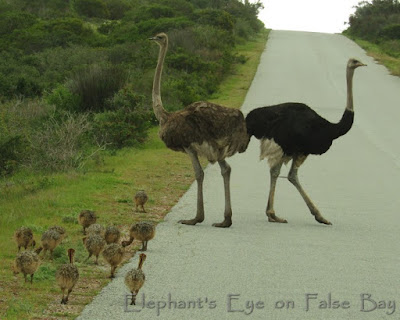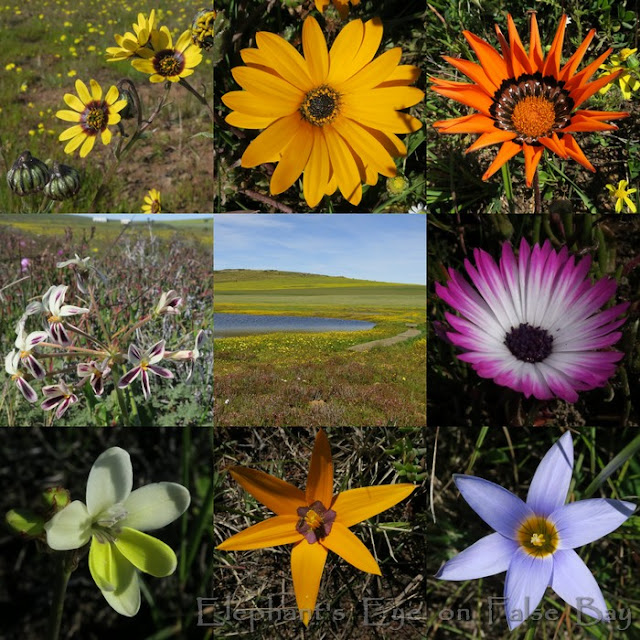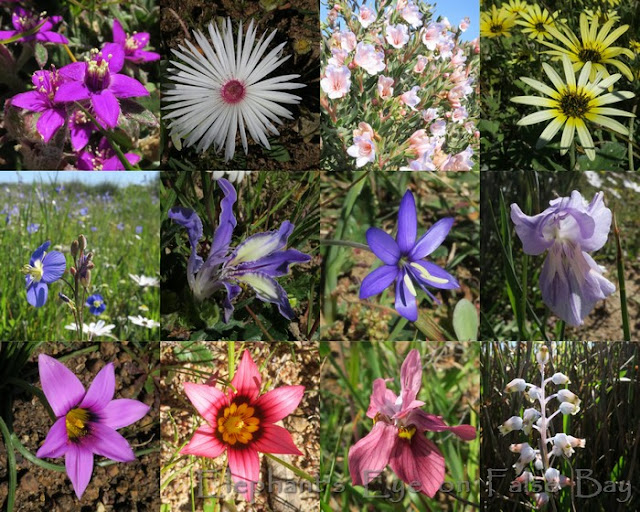West Coast spring flowers
by Diana
Studer
- gardening for biodiversity
in Cape Town, South Africa
Mid-August we took our electric car across country, planning
to recharge the battery overnight where we stayed.
We startled the guards at the West Coast National Park
gate as they waited in the office for incoming cars. 'Didn't hear you coming!'
Electric car is ideal for birdwatching, as we coast to a
gentle halt. Ostrich parents observing us as they stride along, their babies
scurrying along in knots and count-them-all-in stragglers. Black koorhaan is
noisy in between eating - precisely barred black and white feathers on his back.
Silent and without fumes we automagically glide away.
First was a chilly walk on an overcast day. Orange Gazania. Wild rosemary Eriocephalus africanus white with a
cherry heart. Purple Senecio. Pink
fragrant buchu Agathosma thymifolia.
Drumsticks, notched petals Zalusianskya villosa. African spoonbills tucked up for a nap, until
the spoon peeked out for his photo. Spoon to catch water insects in the mud, or
locusts on land. Yellow Cheiridopsis
rostrata. Golden yellow with burgundy splotches Zygophyllum flexuosa.
Purple ruffled Muraltia
spinosa. Lime pink creeper, petal tips swirled together Microloma sagittatum. Obese lily weevil
- adults eat leaves, while the larvae demolish lily family bulbs. Lime gold Euphorbia mauritanica.
Peach Oxalis. Tricolour
Romulea. Painted Babiana. Dusky bruinsalie Salvia
africana-lutea.
We stayed at Masada
guesthouse in Langebaan. Among so many Langebaan 'gardens' which are low maintenance - it was a delight to
see a conservancy estate around our
guesthouse. Full English breakfast buffet included forewarned vegetarian extras
for us - fried mushrooms and potato croquettes with the eggs. The Ungardener
and our host knelt in the rain to sort out the plug in and charge overnight.
Kelp gull with a red tip to its lower beak. Black
oystercatcher - many pairs along the rocks and the Tsaarsbank beach - where I
picked up a convenient hard hat to gather plastic debris in. Cape cormorant
with his wings spread out to dry after fishing in the cold sea. High seas ahead
of the heavy rain which caught us that evening. We went to supper on the shore
of Langebaan lagoon. And a quick walk when we come out? Not a chance, a heavy
downpour caught the car in a 20 cm deep puddle of stormwater.
Second day in Postberg. Blue flax Heliophila enjoying the sun with a mole snake on a chilly not yet
spring day
Fluffy bud and flower are a weird daisy Othonna undulosa. Yellow daisy and cylindrical leaf Crassothonna cylindrica.
Fierce red Pelargonium
fulgidum. Bontebok with his striking brown and white face. White rain
daisies Dimorphotheca pluvialis. Yellow
Arctotis hirsuta.
Striking tiny red Rumex
lativalvis. Orange pea flower Indigofera
procumbens. Duiker quietly browsing in the distance. Yellow Wachendorfia brachyandra.
Purple and white daisies. Blue Moraea. Purple and white Lapeirousia
jacquinii. White Oxalis with a
purple heart.
Tienie Versfeld
wildflower reserve outside Darling. Chocolate hearted Tripteris clandestina. Yellow Arctotis.
Peacock-eyed Gazania
Ivory and burgundy Pelargonium
triste. Wildflower reserve, beyond the fence agri-chemical fields of wheat
and canola. Purple tipped white petals Cleretum
clavatum.
Softly yellow Hesperantha.
Bronze star Spiloxene canaliculata. Sky
blue star Romulea tabularis
Waylands wildflower heritage
thanks to the Duckitt family in Darling. Schiaparelli pink Aizoon paniculatum. Clear white vygie Cleretum bellidiforme (Bokbaai vygie was Dorotheanthus). Statement shrubs Lobostemon. Light and darker yellow Arctotheca calendula.
Heliophiola dotted
across the reserve. Mauve Babiana. Shimmering
azure Geissorhiza aspera. Softest
blue Gladiolus.
Pink Romulea rosea. Harlequin
flower Romulea hirsuta. Dusky pink Moraea tricolor.
Ghostly Lachenalia
sheltering.
Home via Blouberg for an Italian lunch.
I invite you to join us at Elephant's Eye on False Bay.
Please subscribe as you prefer
via Feedly,
or Bloglovin,
Teal blue text is my links.
To read comments if you are in email or a Reader,
first click
thru to the blog)
Thanks for comments that add value. Maybe start a new thread
of discussion? BTW your comment won't appear until I've read it. No Google
account? Just use Anonymous, but do leave a link to your own blog. I would
return the visit, if I could...
I welcome comments on posts from the last 2 months.











You must be in the best place in the world right now with the Spring flowers emerging. But the ostriches stole my heart!
ReplyDeleteYour early spring blooms are incredible. It amazes me that each and every one of your posts introduces me to flowers I've never heard of, much less seen. It's delightful to see an ostrich family out and about like that too.
ReplyDeleteThank you for sharing you "electric" trip, electric in flower as well as in fuel.
ReplyDeleteSuch a peaceful, comfortable contrast to the Land Rover ;~)
DeleteWonderful pictures! gorgeous flowers and wildlife especially the ostrich family, what a beautiful sight!
ReplyDeleteSo many wildflowers! I thought you were going to say the electric car didn't make it to the destination. Glad you traveled safely. Our recent heavy rains here in the middle of the U.S. prompted the advice, "Turn around, don't drown." Sudden, heavy downpours and puddles can be dangerous
ReplyDeleteIt's a new mindset. Planning the journey in suitable chunks.
DeleteBack to - change the horses at the coaching inn :~)
That informal parking on the sand by the lagoon needs some storm water infrastructure. We had innocently parked in The Dip.
Once again, such wonderful photos of your beautiful flowers. We too have spoonbills on our south devon coast, is it global warming that has made them come so far north? Loved the ostriches with their young family, how wonderful to get so close in your electric car, a bird hide on wheels!
ReplyDeleteI enjoyed seeing the wild flowers, some similar to ours, and some not. My favourite is the Blue flax Heliophila. I always think bees are doubly attracted to blue flowers, but I have no facts to back that up!
ReplyDeleteAlso great to see your electric car, unfortunately the price of them is prohibitive in Australia at the moment. (for us, anyway)
Sadly South Africa also offers zero financial incentive to drive an electric car (and prohibitive import duty). It's a heart not head decision.
DeleteEven China encourages its citizens to drive electric!
thanks for filling us in on all the names of all these flower varieties - such diversity of form and colour - Really enjoyed the electric yellow tour
ReplyDeletep.s. I have some hearing loss and in the hubbub of London often don't hear electric cars coming round the corner - I forsee them being fitted with a noise element
I was born with a deaf ear, so intensely aware and extra careful of pedestrians ... approach with caution until I am sure they have SEEN us.
DeleteIt does have a pedestrian warning noise, but not especially helpful.
You outdid yourself with these gorgeous photos, Diana, except for the big bad snake, that I could not like. But the baby ostriches! They are adorable.
ReplyDeleteAmalia
xo
I love how the flowers match your car. Lovely to hear that it is ideal for bird watching as well as being so much better for the environment. We have been investigating electric cars this weekend, Sarah x
ReplyDeleteand for you it will be SO much easier to find public charging points. I look forward to seeing your choice in a blog post one day.
DeleteI hadn't considered the enhanced wildlife viewing opportunities provided by an electric car -- another selling point. I always love seeing your South African flowers, and noticed that quite a few of these are in the six-petaled lily family. I wonder if more Liliaceae bloom in the spring?
ReplyDeleteWe have a truly huge range of bulbs. Spring brings us both annuals and bulbs.
DeleteThe porcupines of Nieuwoudtville can weigh up to 24kg (elsewhere average weight is 14kg). In one square metre here a porcupine could find 25,000 bulbs of various species.
https://eefalsebay.blogspot.com/2015/09/spring-flowers-hantam-NBG-2012-2011-Sept.html